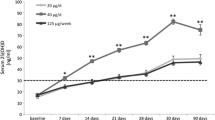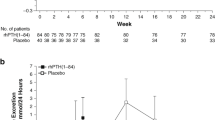Abstract
We compared the effects of oral calcium and vitamin D separately and together on relevant variables in 22 postmenopausal volunteers with initial serum 25OHD levels below 60 nmol/L. Subjects were allocated randomly to two regimens: group 1 received 1 week of calcium 1,000 mg, followed by 7 weeks with additional vitamin D3 1,000 i.u. daily; group 2 received 7 weeks of D3 1,000 i.u. daily, followed by 1 week with additional calcium 1,000 mg. We measured serum calcium, phosphate, PTH, 25OHD, CTX, and ALP at baseline and after 1 and 8 weeks in group 1 and after 7 and 8 weeks in group 2. There were no significant changes in ALP from either vitamin D or calcium. Calcium caused significant elevation of serum 25OHD as well as major suppression of serum CTX, which could not easily be accounted for by suppression of PTH. Vitamin D caused no significant change in any variable except elevation of serum 25OHD. The suppressive effect of calcium (whether given first or second) on serum CTX was threefold greater than that of vitamin D (whether given first or second) (P < 0.001), although their suppressive effects on serum PTH were the same. Calcium and vitamin D yielded greater and more significant effects on all variables (except ALP) than either treatment alone. We suggest that calcium may elevate serum 25OHD by prolonging its half-life and that it may have an inhibitory effect on bone resorption independent of, or in addition to, its suppression of PTH.



Similar content being viewed by others
References
Nordin BEC (2005) The role of vitamin D deficiency in hip fractures. Nutr Abstr Rev Series A 75:33N–44N
Bischoff-Ferrari HA, Dawson-Hughes B, Staehelin HB, Orav JE, Stuck AE, Theiler R et al (2009) Fall prevention with supplemental and active forms of vitamin D: a meta-analysis of randomised controlled trials. BMJ 339:b3692
Revell PA (1986) Pathology of bone. Springer-Verlag, Berlin
Bates CJ, Carter GD, Mishra GD, O’Shea D, Jones J, Prentice A (2003) In a population study, can parathyroid hormone aid the definition of adequate vitamin D status? A study of people aged 65 years and over from the British National Diet and Nutrition Survey. Osteoporos Int 14:152–159
McKenna MJ, Freaney R (1998) Secondary hyperparathyroidism in the elderly: means to defining hypovitaminosis D. Osteoporos Int Suppl 8:S3–S6
Steingrimsdottir L, Gunnarsson O, Indridason OS, Franzson L, Sigurdsson G (2005) Relationship between serum parathyroid hormone levels, vitamin D sufficiency, and calcium intake. JAMA 294:2336–2341
Stein MS, Scherer SC, Walton SL, Gilbert RE, Ebeling PR, Flicker L, Ward JD (1996) Risk factors for secondary hyperparathyroidism in a nursing home population. Clin Endocrinol 44:375–383
Sahota O, Masud T, San P, Hosking DJ (1999) Vitamin D insufficiency increases bone turnover markers and enhances bone loss at the hip in patients with established vertebral osteoporosis. Clin Endocrinol 51:217–221
Melton LJ, Khosla S, Atkinson SJ, O’Fallon WM, Riggs BL (1997) Relationship of bone turnover to bone density and fractures. J Bone Miner Res 12:1083–1091
Garnero P, Sornay-Rendu E, Claustrat B, Delmas PD (2000) Biochemical markers of bone turnover, endogenous hormones and the risk of fractures in postmenopausal women: the OFELY study. J Bone Miner Res 15:1526–1536
Heaney RP (2003) Is the paradigm shifting? Bone 33:457–465
Chapuy MC, Arlot ME, Duboeuf F, Brun J, Crouzet B, Arnaud S et al (1992) Vitamin D3 and calcium to prevent hip fractures in elderly women. N Engl J Med 327:1637–1642
Meunier PJ (1998) Calcium and vitamin D are effective in preventing fractures in elderly people by reversing senile secondary hyperparathyroidism. Osteoporos Int Suppl 8:S1–S2
Tang BMP, Eslick GD, Nowson C, Smith C, Bensoussan A (2007) Use of calcium or calcium in combination with vitamin D supplementation to prevent fractures and bone loss in people aged 50 years and older: a meta-analysis. Lancet 370:657–666
Bischoff-Ferrari HA, Willett WC, Wong JB, Stuck AE, Staehelin HB, Orav EJ et al (2009) Prevention of nonvertebral fractures with oral vitamin D and dose dependency. Arch Intern Med 169:551–561
Lips P (2004) Which circulating level of 25-hydroxyvitamin D is appropriate? J Steroid Biochem Mol Biol 89–90:611–614
Malabanan A, Veronikis IE, Holick MF (1998) Redefining vitamin D insufficiency. Lancet 351:805–806
Dawson Hughes B (2004) Racial/ethnic considerations in making recommendations for vitamin D for adult and elderly men and women. Am J Clin Nutr 80 Suppl:1763S–1766S
Bischoff-Ferrari HA, Giovannucci E, Willett WC, Dietrich T, Dawson-Hughes B (2006) Estimation of optimal serum concentrations of 25-hydroxyvitamin D for multiple health outcomes. Am J Clin Nutr 84:18–28
Bischoff-Ferrari HA (2007) How to select the doses of vitamin D in the management of osteoporosis. Osteoporos Int 18:401–407
Heaney RP (2000) Vitamin D: how much do we need, and how much is too much? Osteoporos Int 11:553–555
Jesudason D, Need AG, Horowitz M, O’Loughlin PD, Morris HA, Nordin BEC (2002) Relationship between serum 25-hydroxyvitamin D and bone resorption markers in vitamin D insufficiency. Bone 31:626–630
Thomas SDC, Need AG, Tucker G, Slobodian P, O’Loughlin PD, Nordin BEC (2008) Suppression of parathyroid hormone and bone resorption by calcium carbonate and calcium citrate in postmenopausal women. Calcif Tissue Int 83:81–84
Stamp TCB, Haddad JG, Twigg CA (1977) Comparison of oral 25-hydroxycholecalciferol, vitamin D, and ultraviolet light as determinants of circulating 25-hydroxyvitamin D. Lancet 1:1341–1343
Meyer HE, Smedshaug GB, Kvaavik E, Falch JA, Tverdal A, Pedersen JI (2002) Can vitamin D supplementation reduce the risk of fracture in the elderly? A randomized controlled trial. J Bone Miner Res 17:709–715
Patel R, Collins D, Bullock S, Swaminathan R, Blake GM, Fogelman I (2001) The effect of season and vitamin D supplementation on bone mineral density in healthy women: a double-masked crossover study. Osteoporos Int 12:319–325
Grant AM, Avenell A, Campbell MK, McDonald AM, MacLennan GS, McPherson GC (2005) Oral vitamin D3 and calcium for secondary prevention of low-trauma fractures in elderly people (Randomised Evaluation of Calcium or vitamin D, RECORD): a randomised placebo-controlled trial. Lancet 365:1621–1628
Barger-Lux MJ, Heaney RP, Dowell S, Chen TC, Holick MF (1998) Vitamin D and its major metabolites: serum levels after graded oral dosing in healthy men. Osteoporos Int 8:222–230
Trivedi DP, Dolly R, Tee Khaw K (2003) Effect of four monthly oral vitamin D3 (cholecalciferol) supplementation on fractures and mortality in men and women living in the community: randomised double blind controlled trial. BMJ 326:469–474
Lyons RA, Johansen A, Brophy S, Newcombe RG, Phillips CJ, Lervy B et al (2007) Preventing fractures among older people living in institutional care: a pragmatic randomised double blind placebo controlled trial of vitamin D supplementation. Osteoporos Int 18:811–818
Chapuy MC, Pamphile R, Paris E, Kempf C, Schlichting M, Arnaud S et al (2002) Combined calcium and vitamin D3 supplementation in elderly women: confirmation of reversal of secondary hyperparathyroidism and hip fracture risk: the Decalyos II study. Osteoporos Int 13:257–264
Krieg MA, Jacquet AF, Bremgartner M, Cuttelod S, Thiébaud D, Burckhardt P (1999) Effect of supplementation with vitamin D3 and calcium on quantitative ultrasound of bone in elderly institutionalized women: a longitudinal study. Osteoporos Int 9:483–488
Dawson-Hughes B, Harris SS, Krall EA, Dallal GE (1997) Effect of calcium and vitamin D supplementation on bone density in men and women 65 years of age or older. N Engl J Med 337:670–676
Grados F, Brazier M, Kamel S, Mathieu M, Hurtebize N, Maamer M et al (2003) Prediction of bone mass density variation by bone remodeling markers in postmenopausal women with vitamin D insufficiency treated with calcium and vitamin D supplementation. J Clin Endocrinol Metab 88:5175–5179
Larsen ER, Mosekilde L, Foldspang A (2004) Vitamin D and calcium supplementation prevents osteoporotic fractures in elderly community dwelling residents: a pragmatic population-based 3-year intervention study. J Bone Mineral Res 19:370–378
Clements MR, Johnson L, Fraser DR (1987) A new mechanism for induced vitamin D deficiency in calcium deprivation. Nature 324:62–65
Clements MR, Davies M, Fraser DR, Lumb GA, Mawer EB, Adams PH (1987) Metabolic inactivation of vitamin D is enhanced in primary hyperparathyroidism. Clin Sci 73:659–664
Eastell R, Riggs BL (2005) Vitamin D and osteoporosis. In: Feldman D, Pike JW, Glorieux FH (eds) Vitamin D, 2nd edn. Elsevier Academic Press, San Diego, pp 1101–1120
Zaidi M, Adebanjo OA, Moonga BS, Sun L, Huang CL-H (1999) Emerging insights into the role of calcium ions in osteoclast regulation. J Bone Miner Res 14:669–674
Nordin BEC (2008) Reflections on osteoporosis. In: Marcus R, Feldman D, Nelson D, Rosen R (eds) osteoporosis, vol 1, 3rd edn. Elsevier Academic Press, San Diego, pp 47–69
Parfitt AM (2003) Misconceptions (3): calcium leaves bone only by resorption and enters only by formation. Bone 33:259–263
Morris HA, Cleghorn DB, Need AG, Horowitz M, Nordin BEC (1995) The 5-year reproducibility of calcium-related biochemical variables in postmenopausal women. Scand J Clin Lab Invest 55:383–389
McKane WR, Khosla S, Egan KS, Robins SP, Burritt MF, Riggs BL (1996) Role of calcium intake in modulating age-related increases in parathyroid function and bone resorption. J Clin Endocrinol Metab 81:1697–1703
Qvist P, Christgau S, Pedersen BJ, Schlemmer A, Christiansen C (2002) Circadian variation in the serum concentration of C-terminal telopeptide of type I collagen (serum Ctx): effects of gender, age, menopausal status, posture, daylight, serum cortisol, and fasting. Bone 31:57–61
Schlemmer A, Hassager C (1999) Acute fasting diminishes the circadian rhythm of biochemical markers of bone resorption. Eur J Endocrinol 140:332–337
Scopacasa F, Horowitz M, Wishart J, Need AG, Morris HA, Wittert G, Nordin BEC (1998) Calcium supplementation suppresses bone resorption in early postmenopausal women. Calcif Tissue Int 62:8–12
Boonen S, Lips P, Bouillon R, Bischoff-Ferrari HA, Vanderschueren D, Haentjens P (2007) Need for additional calcium to reduce the risk of hip fracture with vitamin D supplementation: evidence from a comparative metaanalysis of randomized controlled trials. J Clin Endocrinol Metab 92:1415–1423
Brown JP, Prince RL, Deal C, Recker RR, Kiel DP, de Gregoria LH et al (2009) Comparison of the effect of denosumab and alendronate on BMD and biochemical markers of bone turnover in postmenopausal women with low bone mass: a randomized, blinded, phase 3 trial. J Bone Miner Res 24:153–161
Author information
Authors and Affiliations
Corresponding author
Additional information
The authors have stated that they have no conflict of interest.
Rights and permissions
About this article
Cite this article
Thomas, S.D.C., Need, A.G. & Nordin, B.E.C. Suppression of C-Terminal Telopeptide in Hypovitaminosis D Requires Calcium as Well as Vitamin D. Calcif Tissue Int 86, 367–374 (2010). https://doi.org/10.1007/s00223-010-9354-3
Received:
Accepted:
Published:
Issue Date:
DOI: https://doi.org/10.1007/s00223-010-9354-3




